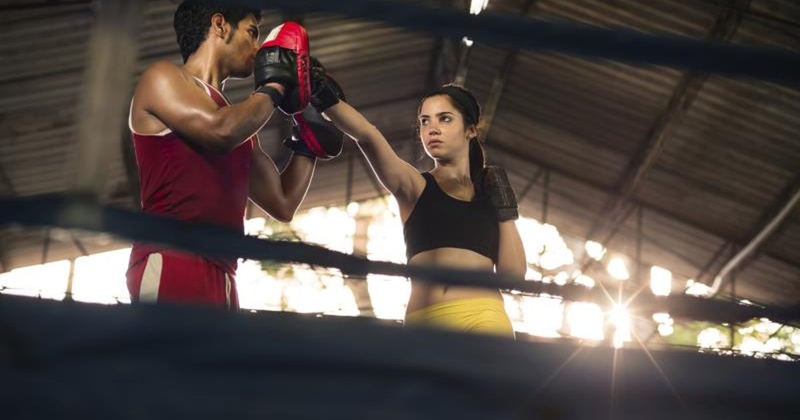If you did not start boxing when you were young, how to train for boxing tips can help you get in shape quickly even though they won’t make you a champion. Yet boxing is practiced by many people who want to know some basic tricks for self-defense or burn more calories in a sporty and entertaining way. After all, how to train for boxing is a first step toward an overall better health.

12 Things You Should Do in Boxing Training
Shadow box
Shadow boxing is a great way to quickly get into shape, because it uses the muscles in your entire body. To have the stamina necessary for a long match, you need to have strong legs for jumps and strong arms for punches. The core muscles must sustain you upright throughout this process and possibly take some punches in the meantime. The best advice on how to train for boxing is to make a daily routine that improves you overall fitness.
Jump rope
Skipping ropes are a fun way to get into shape, burn more calories, and receive great aerobic training. They build resistance in the legs and core muscles, which supports you during the intense effort. In boxing, strong core muscles are extremely useful when it comes to receiving punches without feeling them too much. The legs must withstand the jumps that make you harder to hit and take you closer of farther from your boxing partner (or opponent, depending on how you look at it). You need your legs to be strong and not give in when lactic acid starts building up to give you that burning sensation in your muscles.
Push-ups
Push-ups are definitely necessary in boxing training because they build arm, shoulder, and chest muscles, all of which will be used in boxing later on. If you looked at boxers, you may have noticed that all of them are rather muscular. Their body type allows them to take the occasional punches without too much fuss. More body mass helps you place strong punches in return, and flexible muscles control your moves and aid coordination.
Pull-ups
This is the most badass way to work your way to an upper body worthy of a Greek god. Install a pull up bar in a doorway and start practicing. Grab the bar with both hands and pull yourself to the ceiling. If you can’t do even one pull-up, use a chair to place your legs on and help your arms by pushing up until you have the necessary strength.
Shoulder presses
Shoulder presses are the best asset for a boxer. You will need powerful and resistant shoulder muscles to be able to throw punches. Stand straight and hold weights in both hands, then raise the weights to shoulder height. Lower them and do sets of 10 repetitions.
Vary your training
Rowing, bench presses, and bicep curls are your best friends in this sport. Do strength training as many times per week as you can. Alternate it with aerobic training. Train your feet and legs by short power sprints, and mix them with occasional long distance running every now and then.
Practice your punching technique
This will help you build strength and resistance. Besides improving your stamina, it will keep you safe from injury. A good punch should transfer the force of the blow to your opponent. Don’t stop short and don’t limit your moves; rather, try to hit with the entire weight of your arm. While practicing your punch, focus on both the speed and accuracy. Drive the motion from your elbow rather than your wrist. Your fist should stay in continuation of your arm at all times; the back of your closed hand must be in the straight line with the forearm.
Work on keeping your position compact
Your arms should be near your body to protect it. Save strength and stamina by limiting flailing moves. The legs should remain sturdy and strong to support you in a stable way. Before the boxing posture becomes a second nature to you, you will need to mentally check all these things and correct your posture all the time.
Don’t forget to rest
You can rest actively by relaxing your arm muscles when you’re not punching or defending yourself. This will help you against tiring out too easily. Staying stiff and rigid all the time will create unnecessary stress and exhaust your energy very quickly.
Speed sessions
Speed drills with the punching bag are a great exercise to learn how to train for boxing. The punching bag hung from the ceiling is for speed burst exercises, which are short sessions of 3 to 5 minutes in which you hit the bag with smooth, circular motions. You need to synchronize with the bag and keep your hands constantly moving. This is a very tiring exercise in the beginning but quickly builds your precision of your punches. Coordination and precision will be important later on for your punches to reach a moving target.
Hit a moving target
To practice hitting a moving target, don’t hesitate to give the speed bag a swing before starting to punch it. This is an exercise for those who can already punch the speed bag for a whole 5-minute session. Your boxing partner will be hopping around the floor and a little more difficult to reach than a stationary target. Swinging the large boxing bag before starting your training helps you with this as well.
Practice your footwork
Work on your footwork and improve your technique by regular training. A good boxer shouldn’t be forced to pay attention to the position of his feet. Remain light on your feet all the time and balance yourself on the balls of each foot. Throw in your training session some lower leg and foot exercise every now and then will help a lot.

View All Comments /Add Comment